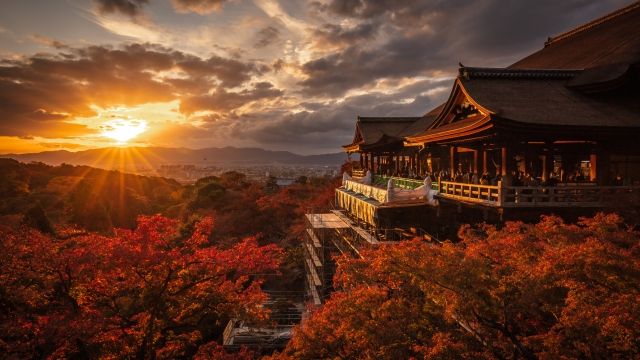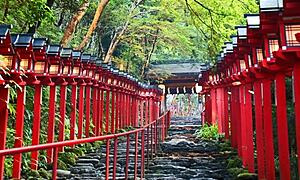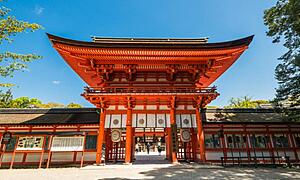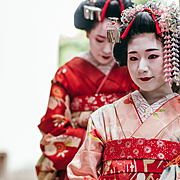Kiyomizu-dera, a top tourist destination in Kyoto that attracts visitors ranging from students and international tourists to locals on a daily basis, has been recognized as a World Cultural Heritage site.
In this article, we provide an abundance of information about Kiyomizu-dera, including its history, highlights, and recommended seasons.
Whether you have already visited Kiyomizu-dera or are planning to go for the first time, reading this will undoubtedly enhance your experience of your visit!
※The information in this article is as of November 2021. Please be aware that the content may have changed, so for the most up-to-date information, please contact the respective facilities in advance.
What is Kiyomizu-dera?"
Kiyomizu-dera," officially named "Otowa-san Kiyomizu-dera," is a temple located in Kyoto City, Kyoto Prefecture.
It is one of the cultural treasures that make up the ancient city of Kyoto, and in 1994, during 6th year of the Heisei era, it was registered as a UNESCO World Cultural Heritage Site along with other iconic landmarks like Kinkaku-ji, Nijo Castle, and Byodoin Temple.
Despite being over 1,200 years old, Kiyomizu-dera has faced numerous fires throughout its history, resulting in the loss of most of its original structures. However, thanks to the unwavering faith of the people, the temple has been reconstructed and repaired multiple times, preserving it to this day.
In recent times, as of December 2020, the main hall's roof was replaced, and the stage of Kiyomizu was re-floored. As a historically significant temple cherished by people, it continues to be bustling with visitors daily.
The History of Kiyomizu-dera

Kiyomizu-dera is believed to have its origins in a monk's dream revelation, how it has had a rich historical journey from its establishment to the present day?
We provide a brief overview of its history from its foundation to today.
T he Beginning of Kiyomizu-dera
Kiyomizu-dera was founded in the 9th year of the Hoki era, which corresponds to the year 778.
In terms of historical context, this takes us back approximately 1,200 years to the Nara period. At that time, a monk named Kenshin, who was undergoing training in Nara, received a divine revelation in a dream, instructing him to 'seek pure water to the north.'
Following this guidance, Kenshin headed north and eventually discovered a pristine waterfall flowing on Mount Otowa. At the base of this waterfall, he encountered a trainee named Gyo'e Koji, who imparted to him a sacred wooden statue, instructing Kenshin to 'carve a thousand-armed Kannon with this sacred wood.'
Gyo'e Koji then disappeared.
Realizing that Gyo'e Koji was an incarnation of the Kannon deity, Kenshin diligently carved the thousand-armed Kannon with the gifted wood and enshrined it in the hermitage believed to be Gyo'e Koji's residence.
This is considered the beginning of Kiyomizu-dera.
E nchin Monk and Sakanoue no Tamuramaro
After carving the thousand-armed Kannon, Kenshin changed his name to Enchin and settled on Mount Otowa. Two years into his residence on Mount Otowa, Enchin had an encounter at the Otowa Waterfall with Sakanoue no Tamuramaro, who was on a deer-hunting expedition for the safe delivery of his pregnant wife.※
Enchin spoke to Tamuramaro about the sin of taking life and the virtues of Kannon, the deity of mercy.
Tamuramaro was deeply moved by Enchin's teachings and is said to have left Mount Otowa. Subsequently, Tamuramaro built his mansion and a temple near the Otowa Waterfall. As the main deity of the temple, he enshrined the Eleven-Faced Kannon Bodhisattva.
Due to the purity of the Otowa Waterfall, the temple was named "Kiyomizu-dera" which has a meaning of "pure" and "Water".
※At that time, deer blood was believed to have the power to grant safe childbirth
T he Recovery of Kiyomizu-dera After Destruction by Fire
In 810, the first year of the Kōnin era, Kiyomizu-dera became an officially recognized temple by the Imperial Court and gradually gained fame nationwide. However, while prospering, it faced numerous fires throughout its history, requiring repeated reconstructions.
Conflicts such as the rivalry between Kōfuku-ji and Enryaku-ji and the Ōnin War are among the historical events that have led to Kiyomizu-dera's documented destruction, with it having been reduced to ashes on 9 occasions.
The most significant of these disasters occurred in 1629, the sixth year of the Kan'ei era when a devastating fire swept through the temple.
After this last major fire, Kiyomizu-dera was reconstructed over a period of approximately two years, thanks to donations from Tokugawa Iemitsu, the third shogun of the Tokugawa family.
H eisei Major Renovation
For nearly 400 years since its reconstruction during the Edo period, Kiyomizu-dera has preserved its historical appearance without major fires.
Nevertheless, being exposed to the elements year-round and visited by tens of thousands of worshippers daily, the buildings naturally undergo wear and tear.
To ensure the preservation of its precious structures for future generations, Kiyomizu-dera conducts large-scale renovations every few decades.
In 2008, the 'Heisei Major Renovation' began, including renovations to various buildings within the temple grounds, such as the Three-Story Pagoda, the Okunoin, and the Amida-do Hall.
In 2020, the rethatching of the main hall's cypress bark roof and the re-flooring of Kiyomizu's stage were successfully completed.
The Highlights of the World Cultural Heritage Site, 【Kiyomizu-dera】

In the spacious precincts of Kiyomizu-dera, there are numerous attractions ranging from world-famous tourist spots to hidden gems.
This time, we have selected and would like to recommend some of the highlights♪
K iyomizu-dera 【Nio-mon Gate】 (National Designated Important Cultural Property)
The 'Nio-mon Gate' is the main entrance to Kiyomizu-dera, and it's the first thing you see after ascending the Kiyomizu slope. It is designated as an Important Cultural Property. Although it was once destroyed during the Ōnin War, it was reconstructed in the late Muromachi period. Subsequently, it underwent disassembly and repairs in 2003.
One interesting feature to note here is the guardian lion-dogs (komainu) in front of the gate.
Typically, you'll find a pair of komainu, one with an open mouth ('Agyo') and the other with a closed mouth ('Un-gyo').
However, at Kiyomizu-dera's Niomon Gate, both komainu have open mouths, which is considered one of the seven mysteries associated with Kiyomizu-dera.
Another attraction near the Niomon Gate is the 'Kankan Kan,' a protrusion on the right side of the entrance.
There's a matching protrusion diagonally opposite it. If you place your ear against one and someone taps the other, you can hear a 'Kankan' sound. The purpose behind this feature remains a mystery.
Consequently, the Kankan Kan is also counted among the seven mysteries of Kiyomizu-dera, similar to the komainu at the Niomon Gate.
K iyomizu-dera 【Nishi-mon (West Gate)】(National Designated Important Cultural Property)
The 'Nishi-mon', which stands for west gate, is a vermilion gate located behind the Niomon Gate. The current Nishi-mon Gate was reconstructed in 1631.
As its name, it faces west, and the sunset view from here is exceptionally beautiful, making it known as a sacred place for 'Nisokan' (日想観)※. The Kyoto scenery seen from the Nishi-mon Gate during the twilight hours is truly special!
If you visit during the evening, why not contemplate the sinking sun from the Nishi-mon Gate and enjoy the serene atmosphere?
※Nisokan: a form of training where one contemplates the Pure Land while watching the sunset in the western sky.
K iyomizu-dera 【Three-Story Pagoda】 (National Designated Important Cultural Property)
The "Three-Story Pagoda" is said to have been founded in 847, the 14th year of the Jōwa era.
However, it has suffered several fires over the years, and the present Three-Story Pagoda is a reconstruction from 1632, the 9th year of Kan'ei, which was disassembled and restored in 1966, the 41st year of Shōwa.
It stands at a height of approximately 31 meters, making it one of the tallest three-story pagodas in Japan.
A highlight here is the dragon adorning the southeast corner of the pagoda.
Typically, pagodas, including three-story and five-story pagodas, have onigawara (ogre tiles) placed at all four corners to ward off evil. However, in the case of the Three-Story Pagoda in Kiyomizu-dera, a dragon decoration is found in the southeast corner instead of onigawara.
This is explained by the fact that in the northwest of Kyoto (Mount Atago), there is a deity for protection from fire. In contrast, there was no protective deity in the southeast, so the dragon, symbolizing protection from fire, was placed there.
The fact that Kiyomizu-dera's Three-Story Pagoda has not suffered significant fires since its reconstruction may be attributed to the dragon's role as a guardian deity.
K iyomizu-dera 【Zuigu-dō Hall】
The "Zuigu-dō Hall" was reconstructed in 1718, the 3rd year of Kyōhō.
Inside this hall, you'll find the enshrined deity, Daizuigu Bosatsu, believed to grant a very auspicious benefit of "wiping away all sins." The hall also houses deities associated with matchmaking, safe childbirth, and child-rearing.
Moreover, Zuigu-dō is a popular spot for experiencing "Tainai meguri."※
Although the main statue of Daizuigu Bosatsu is hidden from view due to its secret status, you can experience the "Tainai meguri" by walking through a narrow space underneath the eaves, symbolizing the deity's womb. It is believed that this experience can grant benefits.
For those seeking a unique journey of spiritual rebirth, a visit to Zuigu-dō is highly recommended.
※Tainai Meguri: A form of spiritual practice where one walks through narrow spaces under the eaves of a temple, symbolizing a symbolic rebirth experience within the womb.
K iyomizu-dera 【Hon-do (Main Hall)】 (National Designated Treasure)
The "Hon-do (Main Hall)" of Kiyomizu-dera, designated as a National Treasure and part of the UNESCO World Cultural Heritage, is estimated to have been founded around the 17th year of Enryaku (in 798).
The building that stands today dates back to 1633, the 10th year of Kan'ei, and enshrines the Eleven-Faced Thousand-Armed Kannon standing statue as its main deity.
The Eleven-Faced Thousand-Armed Kannon is considered a hidden statue, and in principle, it is only revealed to the public once every 33 years during a special viewing.
Instead, you can see its likeness through a statue known as the "Maedachi Butsu," which replicates the Eleven-Faced Thousand-Armed Kannon.
The next scheduled public viewing is planned for 2033, the 15th year of the Reiwa era.
In addition to the main deity, another hidden gem is the iron cane clogs located in front of the Main Hall.
It is said that these items were left behind by the legendary warrior Benkei. Touching them is believed to grant you some of Benkei's strength and fortune.
K iyomizu Stage
Behind the Main Hall, there is the famous "Kiyomizu Stage," known for the saying, "to jump off the Kiyomizu Stage" (a Japanese idiom). (Do not actually jump)
In the past, due to a folk belief that "making a leap from the stage and surviving would make one's wish come true," many people actually jumped from the Kiyomizu Stage.
One remarkable feature of the Kiyomizu Stage is that it was constructed without the use of a single nail. When viewed from beneath the stage, you can see that the wooden framework is intricately assembled in a lattice-like pattern.
This is a traditional construction method known as "kakezukuri." It is also referred to as "Jigoku-gumi" or "Jigoku-dome," as any missing piece of wood can cause the entire structure to collapse with a clattering noise, likened to hell.
While the view of Kyoto from the stage is breathtaking, when you visit, be sure to take a moment to view the stage from below as well.
K iyomizu-dera 【Okuno-in】 (National Designated Important Cultural Property)
Like the Main Hall, the Okuno-in, which was reconstructed in 1633, the 10th year of Kan'ei, enshrines the "Sanmen Senju Kannon Bosatsu" as its main deity.
The Sanmen Senju Kannon Bosatsu is also a hidden statue and not typically visible.
However, you can explore adorable Buddhist statues like the "Fureai Kannon" created for visually impaired individuals, and the "Nurete Kannon" used for "Mizugori"※ which stands for water ablutions※ on behalf of worshippers.
The Fureai Kannon is believed to grant blessings when touched, while the Nurete Kannon is said to purify both the mind and body when water is poured using a ladle.
※Mizugori (Water ablutions): a traditional practice of cleansing the body to prepare for prayer or visiting a shrine or temple.
K iyomizu-dera 【Koyasu-no-tou Pagoda】 (National Designated Important Cultural Property)
The "Koyasu-no-tou Pagoda" is a vermilion three-story pagoda that you can see in front when you ascend to the Kiyomizu Stage.
It belongs to a temple named "Taisan-ji" and enshrines the Thousand-Armed Kannon within.
It is considered a prayer site associated with Emperor Shōmu and Empress Kōmyō, but the exact period when it was constructed remains unclear.
The current Koyasu Pagoda is said to date back to the late Muromachi period.
K iyomizu-dera 【Otowa-no taki Waterfall】
The "Otowa-no-taki" waterfall, historically known as "Golden Water" or "Long Life Water," is the waterfall from which the temple gets its name.
It has been flowing continuously without drying up since the temple's founding, and it is believed that scooping and drinking this water with a ladle can bring blessings.
However, there is a need for caution in how you drink it!
The Otowa-no-taki waterfall is divided into three streams, but you can only choose one.
If you attempt to be greedy and drink from two or three streams, it's said that you'll lose the blessings.
When drinking, it's recommended to take just one sip and not to drink multiple times. This is meant to remind us not to be too greedy in all things.
K iyomizu-dera 【Goshuin】
Kiyomizu Temple serves as the 16th stop of the Saigoku Sanjusansho pilgrimage, as well as the 10th to 14th stop of the Rokuyoji Kannon Pilgrimage in Kyoto.
Due to its multiple roles as a pilgrimage site, it offers various types of 'Goshuin' stamps.
Different areas of the temple, such as the Main Hall, Amida Hall, and the area in front of Otowa Waterfall, provide different types of Goshuin stamps.
Therefore, if you have specific Goshuin stamps in mind that you want to receive, it's important to be attentive to the locations.
You can obtain popular Saigoku Sanjusansho pilgrimage Goshuin stamps conveniently at the side of the Main Hall.
For those embarking on a Goshuin stamp journey, it's recommended to acquire a Goshuincho (Goshuin stamp book) at Kiyomizu Temple.
There are five different designs to choose from, featuring depictions of the Kiyomizu Stage and Buddha's Footprints, among others.
Be sure to find a design that suits your preferences!
K iyomizu-dera 【Jishu Shrine】 (Designated National Important Cultural Property)
Jishu Shrine, located at the back of Kiyomizu Stage, was originally the guardian shrine of Kiyomizu Temple. However, it gained independence from Kiyomizu Temple during the Meiji era due to the separation of Shinto and Buddhism under the government's decree.
It is renowned as a deity of matchmaking, and the "Love Stone Divination" within the shrine's precincts is a popular attraction among tourists.
It is said that if you can walk from one stone to another, about 7 meters away, with your eyes closed, your romantic wishes will come true.
When you visit Kiyomizu Temple, we highly recommend stopping at Jishu Shrine.
What is the recommended season for Kiyomizu Temple?

T he illumination events at Kiyomizu-dera Temple (three times a year)"
Kiyomizu-dera Temple offers special evening illuminations in spring, summer, and autumn, a total of three times a year.
The illuminated temple at night presents a unique and captivating view distinct from the daytime, making it undoubtedly a must-see scenery if your visit coincides with these events.
The main hall, three-story pagoda, and other structures of Kiyomizu Temple bathed in beautiful lights are sure to leave you spellbound.
During the illumination events, as you pass beneath the stage and look up at the sky, you'll also witness a single blue light.
This light is said to represent the compassion of Kannon, the deity of mercy.
T he Autumn Foliage Season
From mid-November to early December is the autumn foliage season at Kiyomizu Temple.
Japanese maple trees within the precincts turn vibrant colors, providing a splendid sight to behold.
Highly recommended spots include the collaboration of Kiyomizu Stage and the autumn foliage, particularly visible from the area around Amida Hall and the Inner Sanctuary.
During the illumination events, the beauty is so stunning that it's bound to leave you in awe.
Additionally, the view from near the Meditation Hall (Hojoike) as you walk from beneath Kiyomizu Stage back to the entrance is exceptional.
The combination of the three-story pagoda, the Western Gate, and the autumn foliage is beautiful, and the reflection of the foliage in the pond is equally stunning.
When you visit during the autumn foliage season, make sure to check out these spots as well!
F or avoid crowds, winter is highly recommended!
Kiyomizu-dera Temple is always bustling with a lot of attractions and a constant stream of visitors throughout the year.
During peak periods like school excursion season and the illumination events, it can be challenging to explore the temple at a leisurely pace.
If you're looking to avoid the crowds and enjoy a more tranquil visit, the winter season is highly recommended.
During the depths of winter, you might even have the chance to admire the serene beauty of snow-covered landscapes from the Kiyomizu Stage.
Access, Parking, and Admission fees at Kiyomizr-dera Temple
H ow to get there?
Address
Kiyomizu 1-chome, 294, Higashiyama-ku, Kyoto 605-0862
Phone Number
(+81) 075-551-1234
Access
【Public transportation】
By Train: Get off at Keihan Main Line's "Kiyomizu-Gojo Station" and walk for approximately 25 minutes.
By Bus: Get off at the "Kiyomizu-michi" bus stop, which is served by city buses and Keihan buses, and walk for about 10 minutes.
【Car】
By Car: It's approximately a 20-minute drive from the "Meishin Expressway Kyoto East Interchange" or about a 10-minute drive from the "Hanshin Expressway Kamogawa Nishi Interchange".
N o public parking
Open Hours
The visiting hours at Kiyomizu Temple vary depending on the season and special events:
September to June:6:00 AM to 6:00 PM
July and August:6:00 AM to 6:30 PM
Special Nighttime Viewing Period:6:00 AM to 9:30 PM (Last entry at 9:00 PM)
Please note that Jishu Shrine has different visiting hours:9:00 AM to 5:00 PM.
The dates for the Special Nighttime Viewing period change from year to year, so it's essential to check the specific dates for the year you plan to visit.
A dmission fee
When visiting Kiyomizu Temple, there is an admission fee to access areas beyond the Main Hall. As of the provided information, the admission fees are as follows:
Adults: 400 yen
Children: 200 yen
Recommended Spots Around Kiyomizu-dera Temple

In the ancient city of Kyoto, besides Kiyomizu Temple, there are numerous captivating shrines and temples.
Now we will introduce recommended spots in the vicinity that you might want to visit alongside Kiyomizu-dera Temple!
K iyomizu -zaka
During the peak seasons, the "Kiyomizu-zaka" can become so crowded with tourists and school excursion groups that you might feel like you're about to bump into other pedestrians.
This road is an uphill stretch of about 700 meters leading to Kiyomizu-dera Temple and is also referred to as the approach to the temple.
The approach is lined with a variety of shops, including souvenir shops, eateries, and even kimono rental stores. You can find a wide range of goods here.
Many shops offer Kyoto gourmet items like Yatsuhashi (a traditional sweet), Yuba (tofu skin), and pickles, so you can enjoy the entire Kyoto tourism right here!
K oudaiji Temple
Kodai-ji Temple was founded by Nene (also known as Kita no Mandokoro), the formal wife of Toyotomi Hideyoshi, in 1606 (Keicho 11th) to pray for the repose of Hideyoshi's soul.
Within its grounds, you can find important cultural properties, such as a memorial hall dedicated to Hideyoshi and Nene, as well as the Umbrella Teahouse (Kasa-tei) that is believed to have been relocated from Fushimi Castle.
The garden, attributed to the renowned garden designer Kobori Enshu, is designated as a Historic Site and Place of Scenic Beauty by the national government.
In recent years, a robot deity known as "Minder" has gained popularity.
Introduced in 2019 (the first year of Reiwa), this android Kannon recites the Heart Sutra and offers easy-to-understand sermons suitable even for upper-grade elementary school students.
Y asaka Pagoda
Located at the end of Sannenzaka (Sannei-zaka) hill, following your visit to Kiyomizu-dera Temple, you will come across the "Yasaka Pagoda," a symbol of Gion, beloved by the people of Kyoto.
Its official name is the "Five-story Pagoda of Hokan-ji Temple," and it is believed to have been founded by Prince Shotoku.
The original pagoda was destroyed during the Onin War and the current Yasaka Pagoda is said to have been rebuilt by Ashikaga Yoshimochi in 1440 (the year of Eikyo 12th).
When you visit Kyoto, this is a place you definitely should not miss.
Whether it's during the day or the evening when it's illuminated by streetlights, you can enjoy a Kyoto-like view at any time.
Y asui Konpira Shrine
Yasaka Kannon Shrine is a Shinto shrine that enshrines Emperor Suiko, Ōomononushi-no-kami (a deity associated with agriculture), and Minamoto no Yorimas.
Within its precincts stands a somewhat unique monument known as the "Enkiiri Enmusubi Hi" or the "Bond-Cutting, Bond-Tying Monument."
This monument, measuring 1.5 meters in height and 3 meters in width, is covered in small wooden votive plaques (ema) inscribed with the wishes of visitors.
It is believed to have the power to "sever all negative ties and establish positive ones."
Due to this, people continue to visit the shrine, and the monument remains a popular site for prayers and offerings.
Conclusion
With a history spanning over 1,200 years, Kiyomizu Temple has weathered numerous fires over the centuries.
Despite these challenges, its original form still stands today, a testament to its enduring popularity among people for centuries.
The various buildings that have been revitalized through major renovations are sure to captivate all who see them.
When visiting the ancient city of Kyoto, be sure to make a stop at Kiyomizu Temple and its attractive spots around, a place full of attractions and rich history.








